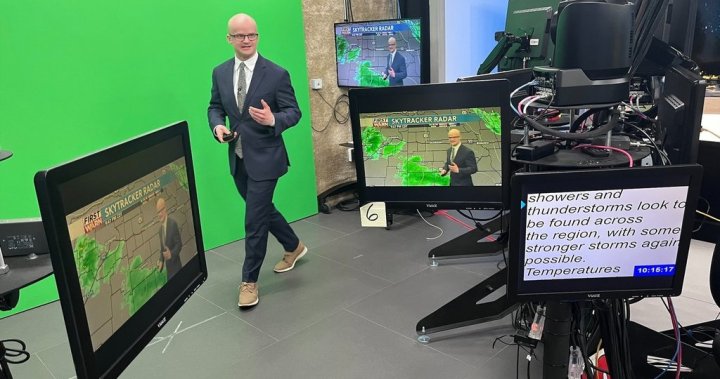Three American TV weather presenters say their viewers’ appetite is soaring for information on the swaths of wildfire smoke drifting in from the Canadian Prairies.
“The smoke has really dominated our weather forecasting headlines,” says Jacob Morse, a meteorologist for KFYR-TV in Bismarck, N.D.
Morse said North Dakota has been hazy all week due to smoke coming from Manitoba and Saskatchewan, where fires have been raging for more than two weeks, forcing more than 30,000 people from their homes.
“We’ve been talking about it constantly. We’re educating viewers on where the fires are and then why the smoke comes here (and the) communities impacted,” he said.
Jacob Morse, a meteorologist for KFYR-TV, a television station in Bismarck, N.D., that’s affiliated with both NBC and Fox News Channel is seen in this undated handout photo.
Courtesy: Jacob Morse via The Canadian Press
Eric Snitil, chief meteorologist for WROC-TV in Rochester, N.Y., says a few years ago, his news network had two or three smoke graphics it projected on its green screens, mainly because of wildfires elsewhere in the United States.
“Now we couldn’t be building these fast enough because of Canada,” Snitil said.
“It’s forcing us meteorologists to not just look out for weather in our own backyard here in New York.
“I find myself now looking at data for Canada and what’s the fire conditions looking like many thousands of miles away.”

He said the appetite from viewers has grown because smoke affects such a large number of people at one time.

Get breaking National news
For news impacting Canada and around the world, sign up for breaking news alerts delivered directly to you when they happen.
Bill Kardas, a chief meteorologist of WKTV in Utica, N.Y., says weather presenters across the U.S. have been ramping up their coverage of Canadian wildfire smoke since 2023.
As Canadians dealt with their worst wildfire season that year, he said his state turned apocalyptically orange from the smoke.
Snitil said meteorologists in New York weren’t prepared.
“Most people around here never experienced anything like the 2023 wildfire smoulder,” said Kardas, a weatherman of 20 years. “There really wasn’t a lot of knowledge as to what was generating this, why is this happening, is this normal, has this ever happened before.”
This year, Kardas said his viewers began to notice smoke in the air last week as blazes on the Canadian Prairies intensified. It has prevented many Americans from leaving their homes, he said.
“We’re 2,000 miles away and we’re feeling the effects of this,” he said.
“I can’t imagine how horrible it must be to be dealing with it in proximity.”

Mike Flannigan is a professor in the University of Alberta’s department of renewable resources and the director of the Western Partnership for Wildland Fire Science.
He said there are two main reasons why Canadian smoke is making international headlines.
First is that there is more smoke and wildfires to begin with, he said.
This year’s fire season — the second worst since the 2023 wildfire season — has seen wildfires consume 3.7 million hectares, six times the area of Prince Edward Island.
“And there’s probably more (smoke) than that because our fires today are burning more intensely and more deeply,” Flannigan said.
Smoke from the flames this year has also crossed oceans and even been detected in Europe.
He said people are paying attention to Canadian wildfires globally because they are more aware of the dangers of smoke as science has evolved.
“I’m a fire guy. We talk about good fire and bad fire. There’s no such thing as good smoke. It’s bad, bad, bad. And it’s becoming more frequent,” Flannigan said.
“It affects IQ, it affects fetus development and of course, lungs. It’s full of thousands of chemicals.”

He said he hopes the global spread of Canadian wildfire smoke encourages more people to think about human-caused climate change.
“We can prevent some of these wildfires through fire bans, forest closures, education,” Flannigan said.
“If (the Earth continues) to warm, we’re going to have longer fire seasons, carry more lightning and drier fields which promote fires.”
© 2025 The Canadian Press



